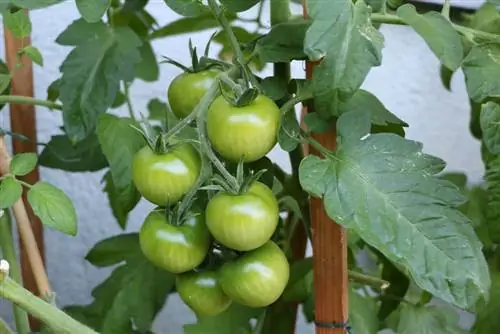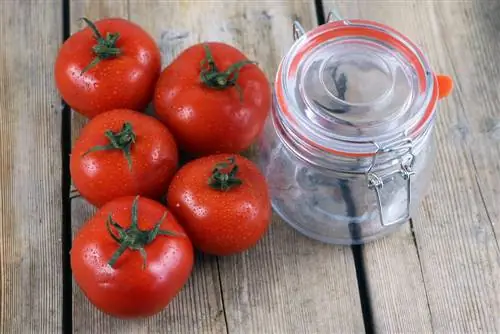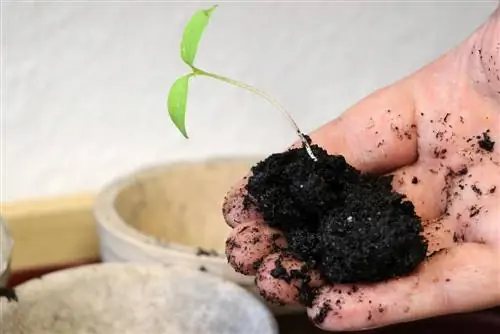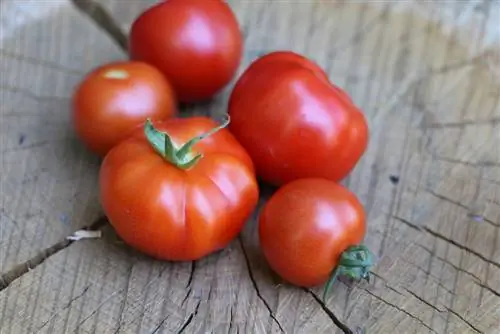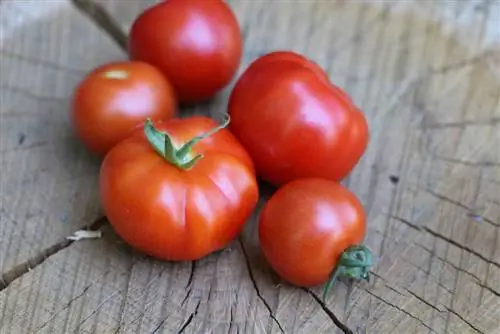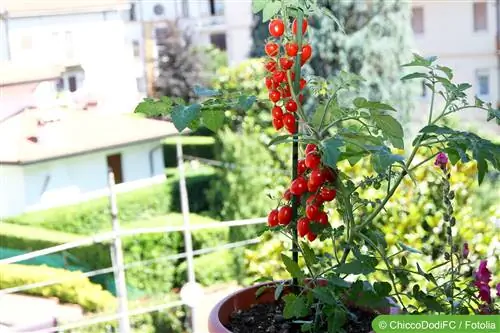- Author admin [email protected].
- Public 2023-12-17 03:39.
- Last modified 2025-06-01 06:48.
If you ask about the secret to successful cultivation of juicy, aromatic tomatoes, the ideal location is at the top of the list of key factors. This guide therefore focuses on the perfect conditions for your tomato plants during cultivation. The focus is on the ideal place during the summer growth and flowering period outdoors and on the balcony. Useful modifications to the site conditions during cultivation or for the purpose of acclimatization are examined here in more detail, as is the optimal quality of bed soil and substrate.
The best outdoor location - light and warmth are key
Tomatoes want a place outdoors from mid/late May that is equal to the conditions in their South American distribution areas. Therefore, assign the demanding exotics a location with these characteristics:
- Sunny to sunny, warm location
- Temperatures between 18 and 28 degrees Celsius
- Ideally with 4 to 6 hours of sunshine daily
- Preferably protected from wind and rain under an eaves
The advantages of a sun-drenched, warm location are in vain if your tomatoes are defenseless against the rain. With every single shower, the sensitive plants are threatened by the devastating late blight and brown rot. The spores of this fungal infection use wind and raindrops to spread explosively on damp tomato leaves. A bed in the wind and rain shadow of a wall or pergola is therefore invaluable for the successful cultivation of tomatoes.
Tomato house optimizes the open-air position
Not every garden can offer locations in the wind and rain shade. Of course, only weather protection makes the location perfect for tomatoes and keeps the dreaded pathogens at bay. Once you have found a place outdoors with the recommended light and temperature conditions, set up a tomato house here. Specialist retailers have ready-made shelters available for you in many sizes and designs.
With a little craftsmanship, you can easily build the shelter yourself. A translucent, weatherproof roof with two closed and two open sides is ideal so that the air can circulate unhindered. When aligning, please make sure that the open sides do not face west. In our regions this is the weather page.
Tips for exemplary soil quality
The fourth criterion in the ideal outdoor location conditions is the soil quality. Only a combination of sun, warmth, weather protection and the right bedding soil ensures profitable cultivation of tasty tomatoes. This soil is particularly suitable for your tomato plants:
- Nutritional, humic and profound
- Fresh to moist, without risk of waterlogging
- A pH value around 6.0
- Preferably lime and clay for an even better taste
You can easily compensate for slight deficits compared to the ideal soil quality with additives. If there is a lack of nutrients because heavy feeders previously grew here, work 3 to 5 liters of mature compost with a few handfuls of horn shavings into the soil. If the soil is not permeable and loose enough, solve the problem with quartz sand or unwashed sheep's wool.
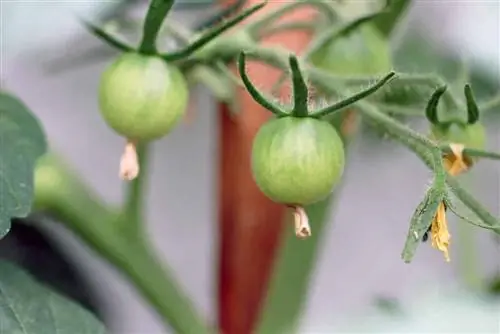
Tip:
Tomatoes grow better if you change the bed every year. Although the nightshade plants are well tolerated by themselves, pathogenic agents accumulate in the soil and lie in wait for the next young tomato plants.
Perfect spot on the balcony - that’s what matters
Growing tomatoes does not necessarily require a garden bed. In the large pot, the tropical plants with the tempting fruits on the balcony also do their best. The prerequisite here is the following location conditions:
- Bright to sunny with at least 4 hours of sunshine daily
- Dry location under an eaves or awning
- Airy yet protected from strong winds
If your balcony does not offer any niches protected from wind and rain, equip the tomatoes in the pot with a hood. Garden centers and hardware stores offer tubular fleeces that you can put over individual plants to protect them. Foil is unsuitable for this purpose as mold and rot can form under the material. Therefore, choose a light and air-permeable special fleece for tomatoes that ensures continuous air circulation.
Tip:
If you grow tomatoes in a greenhouse, shading at midday in summer is essential. If the sun's rays hit the glass roof directly, the temperature in the greenhouse rises to over 30 degrees Celsius. Even sun worshipers such as tomato plants cannot cope with this heat in the long term.
Substrate for balcony tomatoes - natural components
So that your care when choosing a location on the balcony is rewarded with premium quality tomatoes, the importance of the substrate must not be underestimated. Leave pre-fertilized potting soil aside. Instead, we recommend a vegetable soil with purely natural components. To ensure that hungry tomato plants can develop perfectly in the substrate, add horn shavings and compost. You can purchase ready-made, peat-free garden compost in any well-stocked garden center. Please only fill in the substrate mixture once you have created a drainage system made of pottery shards on the bottom of the bucket.
Hardening off prevents sunburn
Their status as tropical sun worshipers sometimes makes us overlook the fact that the leaves on tomato plants are not immune to sunburn. If the purchased or home-grown young plants suddenly move to their sunny location outdoors or on the balcony, leaf damage is inevitable. Sunburn can be recognized by leaf spots that do not spread further and by rolling, curling leaf edges. By allowing young tomatoes to go through a hardening phase, you can effectively prevent this damage.
How to do it:
- From the beginning of May, carry tomatoes in the nursery pot outside during the day
- Place in a partially shaded location protected from wind and rain
- In the evening and in bad weather, put the young plants behind glass
Experience has shown that a period of 10 to 14 days is sufficient for tomato plants to acclimate. Then plant your pupils outdoors or in the pot in mid/end of May.
Tip:
Specialist retailers now also have pre-grown tomato plants available for you as refined varieties. The noble variety sits on a strongly growing wild species as a base. This has the advantage that in the ideal location you can enjoy a yield that is twice as high as with ungrafted plants.
Sowing requires modified location
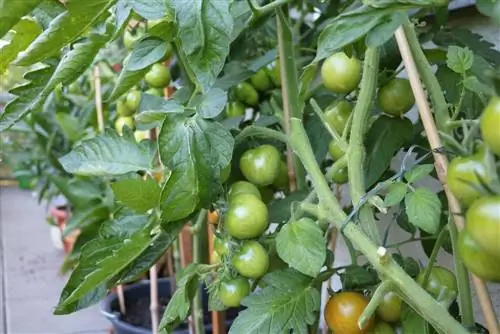
If you prefer to grow tomatoes yourself by sowing seeds, a location in partial shade is required for a short period of time. As long as seedlings are barely rooted, they will languish in direct sunlight. Even though as adult plants they don't appreciate repeated location changes, it is recommended when growing behind glass. How to do it right:
- Seed containers until germination: partially shaded at temperatures between 22 and 26 degrees Celsius
- After germination: bright, not full sun, at temperatures between 18 and 20 degrees Celsius
The temperatures should be lowered and the light supply increased when the third leaf sprouts at the latest. Otherwise there is a risk that the young tomatoes will develop long, weak shoots. If necessary, compensate for any lack of light due to the season with daylight lamps so that strong, sturdy young plants develop.
Conclusion
After reading this guide, you will know the recipe for successful cultivation of tempting tomatoes. By choosing the ideal location, you prepare the tropical nightshade plants for vigorous growth and high productivity. The location outdoors and on the balcony should be sunny, warm, protected from wind and rain. Only when the temperatures rise after the Ice Saints in mid/late May do tomatoes take their place in the open air. Beforehand, the young plants go through a 14-day hardening phase so that they do not suffer sunburn. If the location does not offer reliable weather protection, a simple tomato roof solves the problem. A nutrient-rich, loose, permeable and yet structurally stable soil offers the roots perfect conditions.

